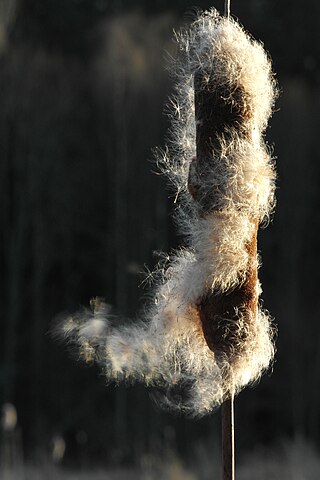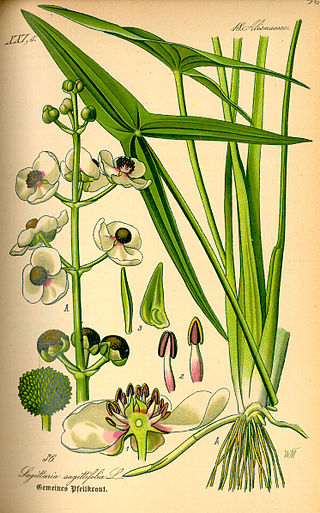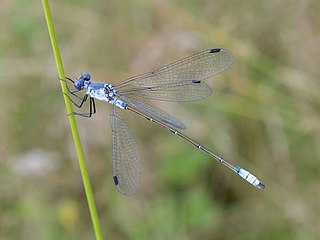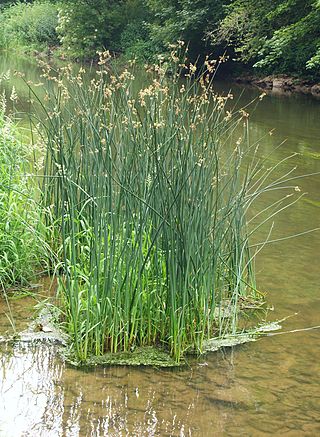
Typha is a genus of about 30 species of monocotyledonous flowering plants in the family Typhaceae. These plants have a variety of common names, in British English as bulrush or reedmace, in American English as reed, cattail, or punks, in Australia as cumbungi or bulrush, in Canada as bulrush or cattail, and in New Zealand as reed, cattail, bulrush or raupo. Other taxa of plants may be known as bulrush, including some sedges in Scirpus and related genera.

The Cyperaceae are a family of graminoid (grass-like), monocotyledonous flowering plants known as sedges. The family is large, with some 5,500 known species described in about 90 genera, the largest being the "true sedges" genus Carex with over 2,000 species.

A straw hat is a wide-brimmed hat woven out of straw or straw-like synthetic materials. Straw hats are a type of sun hat designed to shade the head and face from direct sunlight, but are also used in fashion as a decorative element or a uniform.

A subregion is a part of a larger region or continent and is usually based on location. Cardinal directions, such as south are commonly used to define a subregion.

Lolium is a genus of tufted grasses in the bluegrass subfamily (Pooideae). It is often called ryegrass, but this term is sometimes used to refer to grasses in other genera.

Cynodon is a genus of plants in the grass family. It is native to warm temperate to tropical regions of the Old World, as well as being cultivated and naturalized in the New World and on many oceanic islands.

Sagittaria is a genus of about 30 species of aquatic plants whose members go by a variety of common names, including arrowhead, duck potato, swamp potato, tule potato, and wapato. Most are native to South, Central, and North America, but there are also some from Europe, Africa, and Asia.

Schoenoplectus acutus, called tule, common tule, hardstem tule, tule rush, hardstem bulrush, or viscid bulrush, is a giant species of sedge in the plant family Cyperaceae, native to freshwater marshes all over North America. The common name derives from the Nāhuatl word tōllin, and it was first applied by the early settlers from New Spain who recognized the marsh plants in the Central Valley of California as similar to those in the marshes around Mexico City.

Scirpus is a genus of grass-like species in the sedge family Cyperaceae many with the common names club-rush, wood club-rush or bulrush. They mostly inhabit wetlands and damp locations.

Schoeneoplectus californicus is a species of sedge known by the common names California bulrush, southern bulrush and giant bulrush. It is also sometimes called "tule", but the closely related Schoenoplectus acutus is the species most often referred to by that name.

Lestes macrostigma is a species of damselfly of the family Lestidae, the spreadwings. It is known by the common name dark spreadwing. It is native to much of southern Europe, its distribution extending into western Asia.

Reed boats and rafts, along with dugout canoes and other rafts, are among the oldest known types of boats. Often used as traditional fishing boats, they are still used in a few places around the world, though they have generally been replaced with planked boats. Reed boats can be distinguished from reed rafts, since reed boats are usually waterproofed with some form of tar. As well as boats and rafts, small floating islands have also been constructed from reeds.

Schoenoplectus heterochaetus is a species of flowering plant in the sedge family known by the common name slender bulrush. It is native to North America, where it can be found in scattered locations in Canada and the United States.

Bolboschoenus robustus is a species of flowering plant in the sedge family. It is known by many common names: saltmarsh bulrush, alkali bulrush, sturdy bulrush, seacoast bulrush, stout bulrush, three-cornered sedge or leafy three-cornered sedge, and seaside club-rush.

Bolboschoenus is a genus of plants in the sedge family, of nearly cosmopolitan distribution. Epipaleolithic and Neolithic peoples used ground root tubers of these plants to make the first breads.

Schoenoplectus lacustris, the lakeshore bulrush or common club-rush, is a species of club-rush that grows in fresh water across Europe and some neighbouring areas.

Pelican Lake is a small lake in the southern portion of the Point Reyes National Seashore, northwest of Bolinas. The lake sits at an elevation of 203 feet (62 m) and has an outflow via the short Pelican Lake Creek southwest through a notch in the coastal cliffs onto Double Point's Bolsa Beach. Pelican Lake is one of the five Coast Trail Lakes, along with Bass Lake, Crystal Lake, Ocean Lake and Wildcat Lake. Alamere Falls is about 0.5 miles (0.8 km) to the northwest.

Käthe Seidel (1907-1990) was a German botanist. Seidel was the first researcher to incorporate vegetation into wastewater treatment wetlands, beginning in the 1950s. She was nicknamed "Bulrush Kate" for her use of the common bulrush, Schoenoplectus lacustris. For many years, she led the Limnological Station of the Lower Rhine based in the city of Krefeld. Focusing on studies of the Lower Rhine, the Limnological Station was associated with various institutions that became part of the Max Planck Society.

















